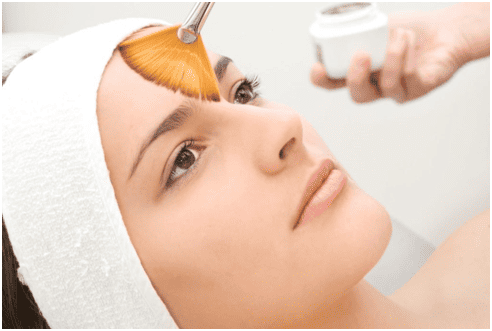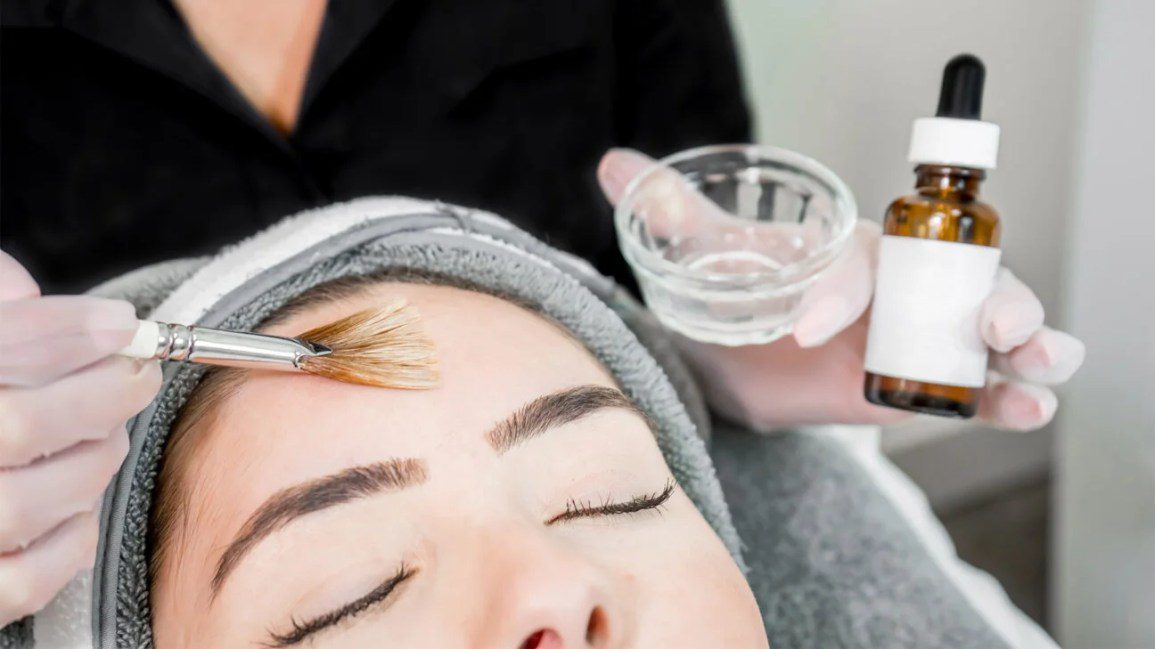CHEMICAL PEELING TREATMENT
Chemical Peels are great facial treatments that will significantly improve and smoothen the texture of your face by removing the damaged outer layers of your skin. Chemical peels have been proven to help treat acne, wrinkles, skin spots or uneven skin tone. Peel formulae may need to be adjusted based on skin type and individual needs. As always, you can contact us for any questions you may have about choosing and performing a chemical peel that is right for you.

FREQUENTLY ASKED QUESTIONS ON CHEMICAL PEELS
Chemical peels have been proven to:
- Improve the texture and appearance of skin
- Reduce lines and wrinkles under the eyes and mouth area
- Help as anti aging and sun damage treatment of wrinkles
- Treat acne and acne scars
- Reduce age spots, freckles and dark spots from pregnancy also known as a condition called melasma.
If you are looking to improve the texture and appearance of your skin due to damage from aging, the sun, acne, acne scarring, or dark spots from pregnancy, you are a good candidate for a chemical peel. If it is your first time using a chemical peel, our expert dermatologists at PLAC will determine the right peel for you. Who is NOT a Good Candidate for a Chemical Peel? You are NOT a good candidate for a chemical peel if any of the following apply at the peel site:
- Infection or disease,
- Cut or broken skin
- Sunburn
- Currently have an active Herpes simplexsore
- If you are nursing or pregnant
- If you currently have Psoriasis, Eczema or Dermatitis You are not a suitable candidate if you have used any of the following drugs in the last 48 hours: Retinoic acid, Prescription skin care products, Products that contain ascorbic acid, bleaching or skin-lightening agents, Other acid products.
A Glycolic acid chemical peel is probably the most widely recognized chemical peeling acids there are. It is a great general type of acid. It is water soluble, and works nicely on most skin types to accelerate the turnover of skin cells, remove lesions, restore steadiness, elasticity and can help to improve the true moisturizing characteristics of the skin. But, just because it is the most popular, it does not mean it is the best acid for your skin..
- Glycolic peel: Normal skin/sensitive skin, fine lines, previous glycolic usage without any irritation.
- 50% Glycolic peel: Normal/acne/aging skin used.
- 70% Glycolic Peel: Normal/aging skin used
A Jessner’s chemical peel is best used for treatment of cystic acne and acne scarring. This chemical peel will cause frosting almost immediately upon application and will provide you with much peeling.
A Lactic Acid chemical peel is best for people who have dry skin, are treating age related imperfections like wrinkles under the eyes and around the mouth area, as well as pigmented skin types. This chemical peel can be used on a weekly basis for moisturization.
An Azelaic acid chemical peel is great for all skin types. It has a low irritation factor with great action! Excellent for Fine lines, Acne-Rosacea, Pigmentation (especially post-inflammatory) and ACNE.
A Salicylic acid chemical peel is ideal for use on heavily clogged pores and people with oily skin and acne. A Salicylic acid chemical peel is available in 3%/15%/25%. It is recommended that you begin with 15% salicylic before you advance to 25%.
A TCA chemical peel is recommended for use on damaged skin including:
- Hyper pigmentation
- Sun Damage
- Pre-CancerousLesions
- Acne
- Lines
- Lip Creases
- Freckling
TCA is applied in multiple layers. We begin with 1 layer and work up to 3-5 layers before moving up to a higher percentage.
- 12.5%: Beginners and Sensitive Skin (1 layer)
- 20%: Advanced (3-5 layers)
- 30%: Professional (1 layer)
- Diluted percentages eq. to scale above.
Always prepare your skin for at least 2 weeks prior to utilizing a chemical peel for best results. If you are prone to hyper-pigmentation, our dermatologists will start you on topicals to help “turn-down” the melanin production in your skin. RetinA, retinol and glycolic acid based serums are all preparation products. A two-week preparation does not guarantee you will not have any pigmentation issues arise during your peel, but it decreases your chances considerably.
Depending upon the type of chemical peel, a reaction similar to sunburn occurs following the procedure. Peeling usually involves redness, followed by scaling that ends within three to seven days. Mild peels may be repeated at one to four-week intervals until the desired clinical effect is achieved. Medium-depth and deep peeling may result in swelling, as well as the presence of water blisters that may break, crust, turn brown, and peel off over a period of seven to 14 days. Medium-depth peels may be repeated in six to twelve months, if necessary. Our dermatologist will work with you to determine the depth of your peel. This joint decision can vary, depending upon the condition of your skin and the objectives of treatment. It is important to avoid exposure to the sun for several months after a chemical peel since the new skin is fragile and more susceptible to complications. Our dermatologist will prescribe the proper follow-up care to reduce the tendency to develop abnormal skin colour after peeling.
In certain skin types, there is a risk of developing a temporary or permanent colour change in the skin after a chemical peel. Taking birth control pills, subsequent pregnancy, or family history of brownish discolouration on the face may increase the possibility of developing abnormal pigmentation. Although low, there is a risk of scarring in certain areas of the face, and certain individuals may be more prone to scarring. If scarring does occur, it can usually be treated with good results. There is a small risk of reactivation of cold sores in patients with a history of herpes outbreaks. This problem is treated with medication as prescribed by our dermatologist. You may be given medication before or immediately after the peel in order to prevent a herpes outbreak. Prior to treatment, it is important for a patient to inform the physician of any past history of keloids (scar tissue overgrowth created at the site of a skin injury) or unusual scarring tendencies, as well as any history of X-rays treatments to the face or recurring cold sores.


